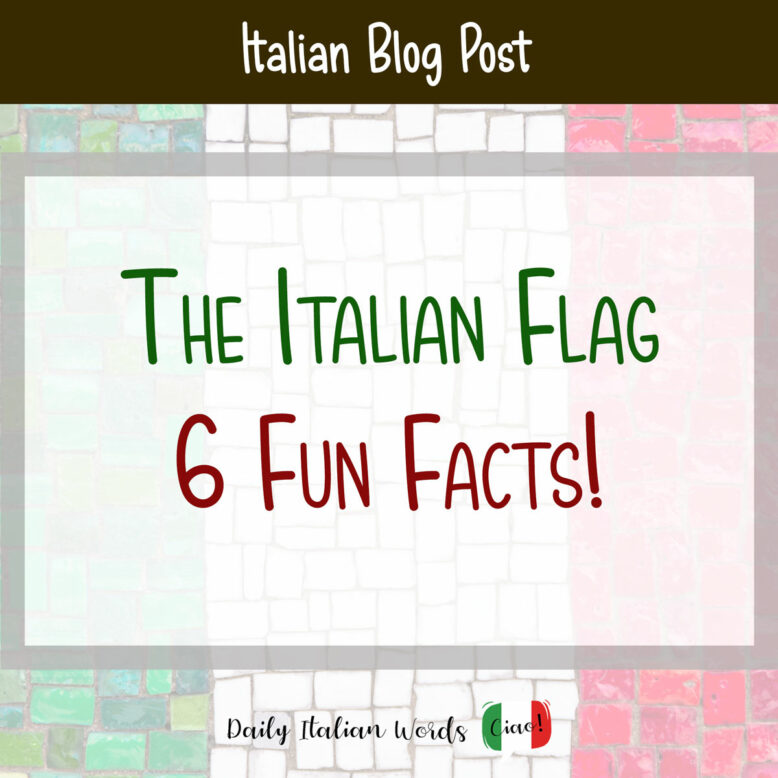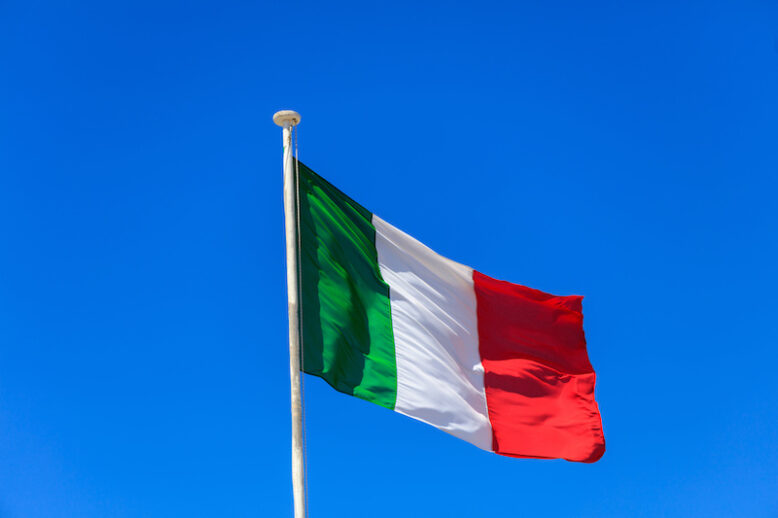How much do you know about the Italian flag? Discover the captivating story behind the Tricolore with these six intriguing facts!
Quanto conosci la bandiera italiana? Scopri l’affascinante storia del Tricolore con queste sei curiosità!

1. It’s older than the Italian State
Normally, you’d expect a national flag to debut alongside the country it represents, right? Well, Italy likes to do things a bit differently – so much so that the Italian flag actually predates the Italian state!
The Italian flag was born on January 7, 1797 – that’s a good 64 years before Italy officially became a unified country in 1861. And you wouldn’t guess where this happened! More on that in the next point.
Additionally, the flag had to wait 128 years for an official legislative recognition that defined its precise features. This came in 1925 with a law outlining the norms for the use of the national flag. By the way, it’s called the Tricolore in reference to its trio of vibrant colors!
1. Esiste da prima dello Stato Italiano
Di solito, ci si aspetta che una bandiera nazionale faccia la sua comparsa insieme al Paese che rappresenta, giusto? Beh, l’Italia, si sa, ama fare le cose un po’ diversamente… tant’è che la bandiera italiana è nata prima dello Stato stesso!
La bandiera italiana nacque il 7 gennaio 1797, ben 64 anni prima che l’Italia diventasse ufficialmente uno stato unitario nel 1861. E non indovinerete mai dove è successo! Ne parleremo nel prossimo punto.
Inoltre, la bandiera ha dovuto attendere 128 anni prima di ottenere un riconoscimento legislativo ufficiale che ne definisse le sue precise caratteristiche. Ciò avvenne nel 1925 con una legge che delineava le norme fondamentali per l’uso della bandiera nazionale. A proposito, è chiamata Tricolore in riferimento ai suoi tre colori!

2. It was born in Reggio Emilia
If you were betting on Rome as the birthplace of the Italian flag, prepare to be surprised! It actually originated in Reggio Emilia, between Parma and Bologna. While it might be unfamiliar to some, this pretty town is celebrated for its top-notch preschools, the site of Italy’s very first mural back in the 1940s, and, well, for proudly bearing the title la città del Tricolore (the tricolour’s town)!
It’s here, on that fateful day in January 1797, that the Italian flag was adopted by the Cispadane Republic, one of the earliest republics to appear on Italian soil. This republic included Reggio, Modena, Ferrara and Bologna, cities that Napoleon Bonaparte had liberated from their old tyrannical governments during his first campaign in Italy, starting to dismantle the system of states into which the peninsula was traditionally divided.
As you can imagine, the adoption of the flag in such context carried a profound meaning, serving as a powerful symbol of pride and identity and igniting those ideals that would later fuel the Risorgimento, the movement for the unification of Italy.
Today, the birthplace of the flag has become part of the local town hall, while the Museo del Tricolore next door chronicles the flag’s remarkable journey through history.
2. È nata a Reggio Emilia
Pensate fosse nata a Roma, vero? E invece no, è successo da tutt’altra parte! La bandiera italiana, infatti, è nata a Reggio Emilia, una graziosa cittadina tra Parma e Bologna famosa per i suoi asili considerati tra i migliori al mondo, per aver ospitato il primo murales d’Italia negli anni ’40 e, beh, per essere la città del Tricolore!
È qui, in quel fatidico giorno di gennaio del 1797, che la bandiera italiana fu adottata dalla Repubblica Cispadana, una delle prime repubbliche nate nel territorio italiano. Questa repubblica includeva Reggio, Modena, Ferrara e Bologna, città che Napoleone Bonaparte aveva liberato dai vecchi governi tirannici durante la sua prima campagna in Italia, con cui iniziò a smantellare il vecchio sistema di stati in cui era tradizionalmente divisa la penisola.
Come potete immaginare, la nascita della bandiera in tale contesto assunse un significato profondo, simbolo potente di orgoglio e identità, accendendo quegli ideali che avrebbero poi alimentato il Risorgimento, il movimento per l’unificazione dell’Italia.
Oggi, la sala che vide la nascita della bandiera è parte del comune di Reggio Emilia, mentre il Museo del Tricolore racconta il meraviglioso viaggio della bandiera italiana attraverso la storia.

3. The Italian flag originated from the French one
As you might have guessed by now, the Italian flag has some French genes in its DNA! Not only was the context in which the flag was born influenced by France, but the Italian flag itself is inspired by the French one. More precisely, from the three colours adopted during the French Revolution, which became a powerful symbol of freedom at the time.
But here’s where it gets interesting. Back in the day, there were no news channels, and information traveled by word of mouth, often with quite a few inaccuracies (well, even nowadays news are not always accurate, to be perfectly honest…). One popular rumor was that the French revolutionary flag’s colours were white, red, and green, with green supposedly chosen by a people’s referendum for its hopeful vibes. The problem is that the French tricolour ended up using blue, not green. But Italy missed that.
So, the Italian revolutionaries, eager to follow in the footsteps of their French neighbours, adopted green, white, and red to rebel against their local governments. Among them were two Bolognese students, Luigi Zamboni and Giovanni Battista De Rolandis who, in 1794, led an uprising against the Papal State ruling over their city. Wearing green, white, and red cockades, they sought to mirror the revolutionary fervor of the French, seeing themselves as part of a broader movement for change.
Needless to say, their rebellion didn’t go as planned. Zamboni ended up in prison, and De Rolandis met a grim fate with a public execution. But the colours they championed stuck around.
3. La bandiera italiana trae origine da quella francese
Come avrete intuito, la bandiera italiana ha qualche gene francese nel suo DNA! Non solo il contesto in cui è nata è stato influenzato dalla Francia, ma la stessa bandiera italiana si ispira a quella francese. Più precisamente, ai tre colori adottati durante la Rivoluzione francese, che divennero un simbolo di libertà a quel tempo.
Ma ecco la parte più interessante. Ai tempi non esistevano i telegiornali e le notizie venivano diffuse per passaparola, spesso con parecchie imprecisioni (beh, anche oggi non è che siano sempre così accurate…). La voce che arrivò in Italia era che i colori della bandiera rivoluzionaria francese fossero bianco, rosso e verde, con il verde scelto, a quanto si diceva, come simbolo di speranza attraverso un referendum popolare. Il problema è che il tricolore francese finì per usare il blu, anziché il verde. Ma l’Italia questo non lo sapeva.
Fu così che i rivoluzionari italiani, desiderosi di seguire le orme dei loro vicini francesi, adottarono il tricolore verde, bianco e rosso come simbolo di ribellione contro i governi locali. Tra questi rivoluzionari c’erano due studenti bolognesi, Luigi Zamboni e Giovanni Battista De Rolandis che nel 1794, quando Bologna era sotto il dominio dello Stato Pontificio, organizzarono una rivolta popolare, sfoggiando coccarde di colore verde, bianco e rosso come simbolo rivoluzionario, proprio come i francesi.
Inutile dire che la loro rivolta non andò esattamente come previsto. Zamboni finì in prigione, e De Rolandis fu giustiziato pubblicamente. Ma quei colori continuarono ad essere usati.

4. Its three colours have multiple meanings
The meanings associated with the flag’s three colours – green, white and red – have sparked a variety of interpretations over the years. Some believe that green represents the lush Italian landscapes, white symbolises the snowy peaks of the Alps, and red pays tribute to the brave soldiers who sacrificed their lives for Italy’s unification. If you’re more inclined towards a spiritual explanation, some say these colours stand for the three theological virtues: green for hope, white for faith, and red for charity.
Beyond their meaning, what’s interesting to note is that the Italian flag’s official colours were only standardised in 2004 – over two centuries after the flag first waved in the wind! Before that, picking the right shades of green, white, and red was a a rather subjective choice. At times, the red even veered towards an orangish hue!
The official hues are fern green (Pantone 17-6153), brilliant white (Pantone 11-0601), and scarlet red (Pantone 18-1662). So now, next time you see the Italian flag, you can impress your friends with your knowledge!
4. I suoi tre colori hanno molteplici significati
I significati associati ai tre colori della bandiera italiana – verde, bianco e rosso – sono stati oggetto di diverse interpretazioni nel corso degli anni. Alcuni ritengono che il verde rappresenti i rigogliosi paesaggi italiani, il bianco le cime innevate delle Alpi, e il rosso renda omaggio ai valorosi soldati che persero la vita per l’unificazione italiana. C’è poi chi pensa che questi colori rappresentino invece le tre virtù teologali: il verde la speranza, il bianco la fede e il rosso la carità.
Al di là del loro significato, è interessante notare che i colori ufficiali della bandiera italiana sono stati standardizzati solo nel 2004 – oltre due secoli dopo che la nascita della bandiera! Prima di allora, infatti, la scelta della tonalità di verde, bianco e rosso era piuttosto libera, tanto che non era raro vedere bandiere più tendenti all’arancione che al rosso.
I colori ufficiali sono dunque il verde felce (Pantone 17-6153), il bianco brillante (Pantone 11-0601) e il rosso scarlatto (Pantone 18-1662). La prossima volta che vedrete sventolare la bandiera italiana, potrete sfoggiare questi dettagli con i vostri amici!

5. Its orientation wasn’t always vertical
When it was first created in 1797, the Italian flag sported horizontal bands, with the red one at the top. Centred amidst these bands were the initials of the republic, R and C (Repubblica Cispadana), accompanied by a quiver with four arrows symbolising the unity of the four cities that were part of such republic.
Over the years, the arrangement of the colours underwent various transformations, at one point even featuring three quadrilaterals nested within each other. Then, in 1848, the House of Savoy adopted a version with vertical stripes, featuring the emblem of their royal house at its center, encircled by light blue. This flag remained in use following the unification of Italy in 1861 and up to 1946 when, with the constitutional referendum signaling the end of the monarchy and the birth of the Italian Republic, the Savoy emblem was removed, leaving the flag adorned solely with its three vertical stripes, as seen today. Nevertheless, the significance of that light blue colour remained very important for Italy…
#5 Non è sempre stata a strisce verticali
Quando nacque nel 1797, la bandiera italiana presentava bande orizzontali, con il rosso in cima. Al centro, le iniziali della Repubblica Cispadana, R e C, accompagnate da una faretra con quattro frecce che simboleggiavano l’unità delle quattro città che facevano parte di tale Repubblica.
Negli anni, la disposizione dei colori subì varie trasformazioni, arrivando anche a presentarsi sotto forma di tre quadrilateri sovrapposti. Poi, nel 1848, i Savoia adottarono una versione a strisce verticali, con l’emblema della loro casa reale al centro, circondato di azzurro. Questa bandiera rimase in uso anche dopo l’unificazione nel 1861 e fino al 1946 quando, con il referendum costituzionale che segnò la fine della monarchia e la nascita della Repubblica Italiana, l’emblema dei Savoia fu rimosso, mantenendo solo le tre strisce verticali, come le vediamo oggi. Nonostante ciò, quell’azzurro è rimasto molto importante per l’Italia…

6. So, what’s with that light blue?
Sports fans may be wondering why light blue is the go-to color for Italian sports teams and athletes instead of the hues from the national flag. Well, the reason takes us back to 1911 when the Italian national soccer team, during a match in Milan against Hungary, took to the field with a light-blue jersey as a tribute to the Savoys – the reigning dynasty of Italy at the time, who had light-blue in their banner.
Since then, light blue not only remained the colour for the national football team but also took hold in other sports, until it became the official colour of Italian sport – except for that brief black jersey phase during Mussolini’s era. This colour is so ingrained in Italian sports culture that male athletes and teams are affectionately called Gli Azzurri (The light blue ones) while female athletes and teams are Le Azzurre (the light blue ones)!
Oh, and about that match against Hungary? Let’s just say Italians may have lost 0-1, but they sure looked stylish in those light-blue jerseys!
6. E quell’azzurro?
Gli appassionati di sport si staranno chiedendo come mai il colore principale delle squadre e degli atleti italiani è l’azzurro anziché uno dei colori della bandiera nazionale. Per scoprire il motivo dobbiamo tornare al 1911, quando la nazionale italiana di calcio, durante una partita a Milano contro l’Ungheria, scese in campo con una maglia azzurra in omaggio ai Savoia – la dinastia che regnava in Italia all’epoca e il cui stemma conteneva proprio l’azzurro.
Da allora, l’azzurro non solo è rimasto il colore della nazionale di calcio, ma si è diffuso anche in altri sport, fino a diventare il colore ufficiale dello sport italiano – eccetto per la breve parentesi fascista che impose le maglie nere. L’azzurro è così radicato nella cultura sportiva italiana che gli atleti e le squadre maschili sono soprannominati “Gli Azzurri”, mentre le atlete e le squadre femminili sono “Le Azzurre”.
E quella partita contro l’Ungheria? Beh, l’Italia perse 0-1, ma sicuramente vinse in fatto di stile con quelle maglie azzurre!


Valentina Nicastro is a travel writer in love with her home country, Italy. Having travelled widely around the globe, she realised there was more to explore closer to home and decided to put the passport aside for a while. When she is not immersed in documenting Italy, you’ll find her donning her communication consultant hat, weaving words as a content writer and bridging linguistic divides as a translator.


